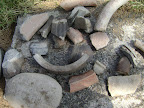



Regarding impact of Pottery shards in the soil there were several questions. I had been searching for pottery shards in the agricultural fields and most often and I got to see some pottery shards in the field. Where ever agriculture was the main livelihood, high densities of populations existence, civilization at the helm and space was a constraint, innovations were adopted by humans, and such practices are sustainable even now.
For more photographs and relevant links see
http://e-potteryshardssoil.blogspot.com/
The charcoal and pottery shards are the two most common by-products of human habitats. At least some charcoal / biochar along with ash was contributed by the people living in habitations in the past (see table in the above link). The availability of the quantity of such by-product, ingenious use, management and development are the aspects still to be discovered. If charcoal / pottery shards did not occur in certain areas in spite of human settlements existence, than there must be some reason yet to be discovered. But both charcoal and pottery existence as a result of human activities was beyond history, so there is no reason why these things are not seen.
The fired pottery made up of clay is most popular. Still the poor people in rural villages in parts of India cook in the clay pots. The pots used for drinking water collection is most common, even today millions of pots are produced and used all over India every year, the usage would be more especially during summers. The evaporation of the water from the fine pores of the pot cool the water inside the pot. The temperature would be at least 5 deg centigrade less than the surrounding air temp. The cooling effects would be very high under less relative humidity conditions. The roofs made up of clay tiles also provide cool shelter, and very much useful in the tropics where temperatures are very high during summers. For majority of the main festivals pots or pottery items are used. From Birth to death, for all important occasions pottery items are used.

